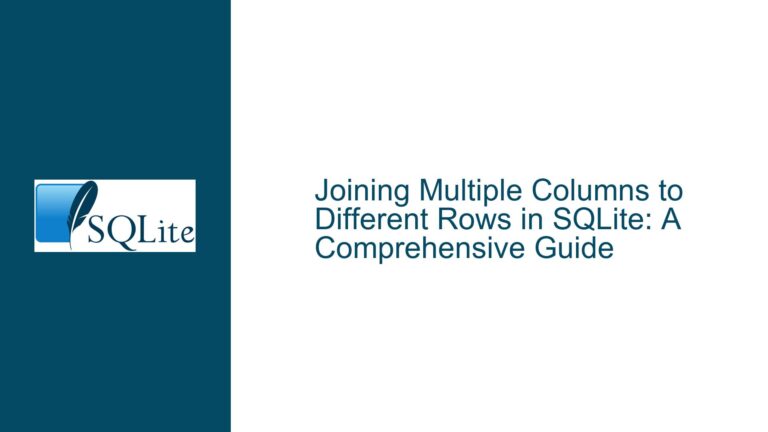SQLite SELECT Queries Without a FROM Clause
SQLite SELECT Syntax and the FROM Clause Ambiguity
The SQLite SELECT statement is one of the most fundamental and frequently used commands in SQLite. It retrieves data from one or more tables or subqueries, and its syntax is defined by a combination of clauses, including the FROM clause. The FROM clause specifies the table or subquery from which to retrieve the data. However, a peculiar ambiguity arises when the FROM clause is present but not followed by any table or subquery. This situation is not explicitly documented in the SQLite syntax diagrams, leading to confusion among developers.
The syntax diagram for the SELECT statement in SQLite appears to allow a FROM clause without any subsequent table or subquery. This ambiguity is further compounded by the fact that the SQLite documentation states that if a FROM clause is specified, the data on which a simple SELECT query operates comes from the one or more tables or subqueries listed after the FROM clause. But what happens when the FROM clause is present but not followed by any table or subquery? This is the core issue that needs to be addressed.
The confusion stems from the fact that the SQLite parser, as implemented in the source code, does not allow a FROM clause without a subsequent table or subquery. This discrepancy between the syntax diagram and the actual parser behavior has led to misunderstandings and potential errors in SQLite queries. The issue is further complicated by the fact that some developers have historically used SELECT statements without a FROM clause, relying on the fact that SQLite allows expressions in the SELECT list that do not reference any table.
The Role of the SQLite Parser in Enforcing Syntax Rules
The SQLite parser, as defined in the src/parse.y file, is responsible for enforcing the syntax rules of the SQLite language. According to the parser’s grammar, a FROM clause must be followed by at least one table or subquery. If the FROM clause is present but not followed by any table or subquery, the parser will generate a syntax error during the preparation phase of the query. This behavior is consistent with the SQLite documentation, which states that the FROM clause is optional but, if present, must be followed by at least one table or subquery.
The confusion arises because the syntax diagram, as presented in the SQLite documentation, does not clearly indicate that a FROM clause without a subsequent table or subquery is invalid. This discrepancy has led some developers to believe that such a query is valid, when in fact it is not. The parser’s behavior is the definitive source of truth in this case, and it clearly indicates that a FROM clause without a subsequent table or subquery is not allowed.
The issue is further complicated by the fact that some SQLite queries do not require a FROM clause at all. For example, a SELECT statement that consists solely of expressions, such as SELECT 1, datetime(...), trim(...);, is perfectly valid in SQLite. In this case, the SELECT statement does not reference any table, and therefore does not require a FROM clause. However, this is a different scenario from the one in question, where a FROM clause is present but not followed by any table or subquery.
Resolving the Ambiguity: Best Practices and Solutions
To resolve the ambiguity surrounding the FROM clause in SQLite SELECT statements, it is important to understand the distinction between SELECT statements that do not require a FROM clause and those that do. A SELECT statement that does not reference any table, such as SELECT 1, datetime(...), trim(...);, does not require a FROM clause and is perfectly valid. However, a SELECT statement that includes a FROM clause must be followed by at least one table or subquery. If the FROM clause is present but not followed by any table or subquery, the SQLite parser will generate a syntax error.
To avoid this issue, developers should ensure that any SELECT statement that includes a FROM clause is followed by at least one table or subquery. If the SELECT statement does not reference any table, the FROM clause should be omitted entirely. This approach ensures that the query is both syntactically correct and semantically meaningful.
In cases where a FROM clause is required but no table or subquery is available, developers can use a dummy table or subquery to satisfy the syntax requirements. For example, in Oracle, the DUAL table is often used for this purpose. The DUAL table is a special table that contains a single row and a single column, and it is commonly used in queries that do not reference any actual table. While SQLite does not have a DUAL table, developers can create a similar dummy table or use a subquery that returns a single row and column.
For example, the following query uses a subquery to satisfy the FROM clause requirement:
SELECT 1, datetime('now'), trim(' example ')
FROM (SELECT 1 AS dummy);
In this query, the subquery (SELECT 1 AS dummy) returns a single row and column, which satisfies the FROM clause requirement. This approach ensures that the query is syntactically correct while still achieving the desired result.
Another approach is to use the VALUES clause, which allows you to specify a set of rows directly in the query. For example:
SELECT 1, datetime('now'), trim(' example ')
FROM (VALUES (1));
In this query, the VALUES clause specifies a single row with a single column, which satisfies the FROM clause requirement. This approach is particularly useful when you need to generate a result set without referencing any actual table.
Conclusion: Ensuring Correct Syntax and Avoiding Common Pitfalls
The ambiguity surrounding the FROM clause in SQLite SELECT statements can lead to confusion and potential errors in SQLite queries. To avoid these issues, developers should ensure that any SELECT statement that includes a FROM clause is followed by at least one table or subquery. If the SELECT statement does not reference any table, the FROM clause should be omitted entirely. In cases where a FROM clause is required but no table or subquery is available, developers can use a dummy table or subquery to satisfy the syntax requirements.
By following these best practices, developers can ensure that their SQLite queries are both syntactically correct and semantically meaningful. This approach not only avoids potential errors but also makes the code more readable and maintainable. Understanding the nuances of the SQLite SELECT syntax and the role of the FROM clause is essential for writing effective and efficient SQLite queries.
In summary, the key takeaways are:
- A FROM clause in a SELECT statement must be followed by at least one table or subquery.
- If a SELECT statement does not reference any table, the FROM clause should be omitted.
- In cases where a FROM clause is required but no table or subquery is available, use a dummy table or subquery to satisfy the syntax requirements.
- Always refer to the SQLite parser’s behavior as the definitive source of truth for syntax rules.
By adhering to these guidelines, developers can avoid common pitfalls and ensure that their SQLite queries are both correct and efficient.






